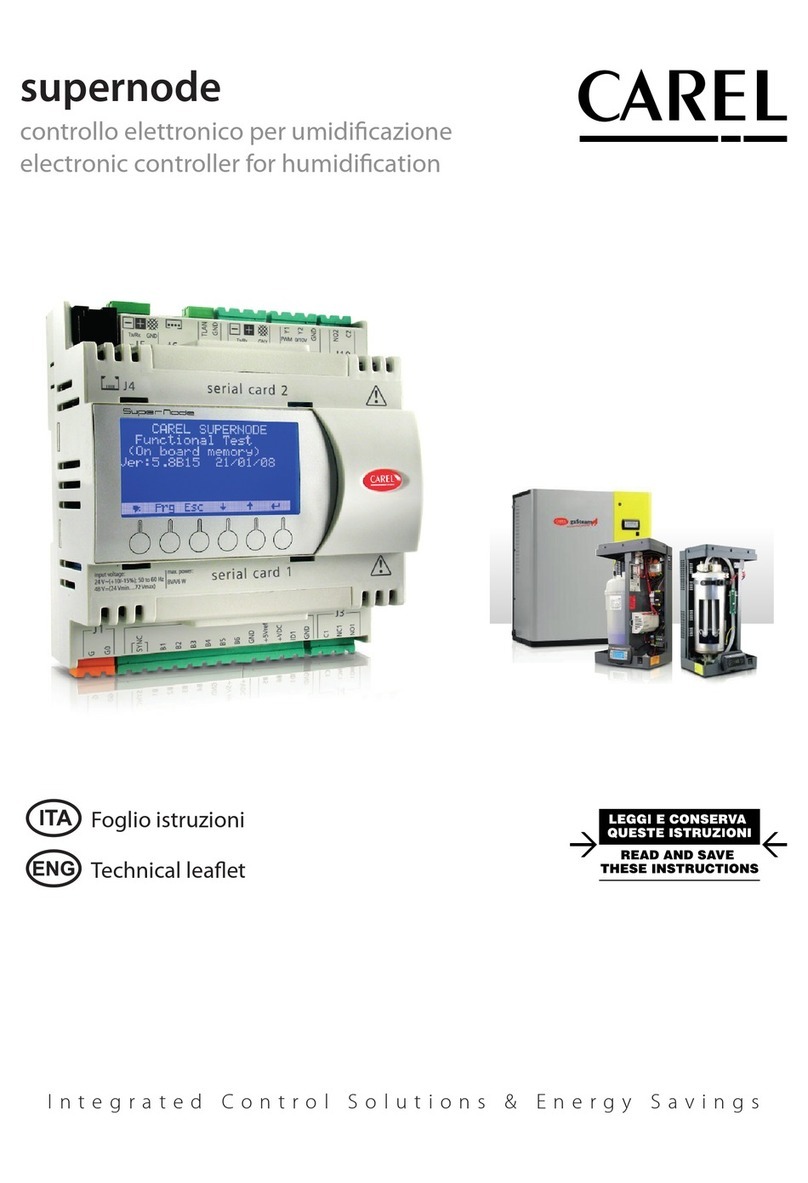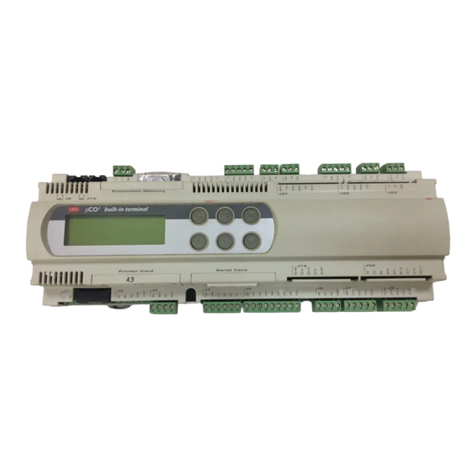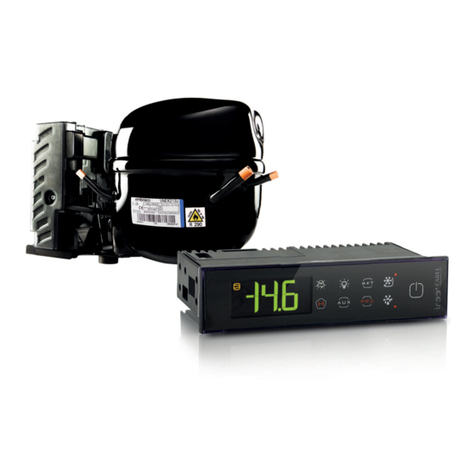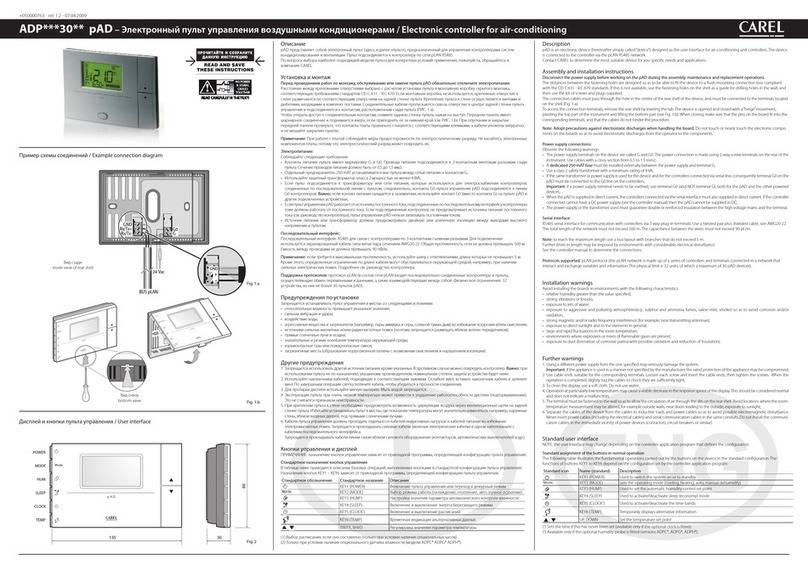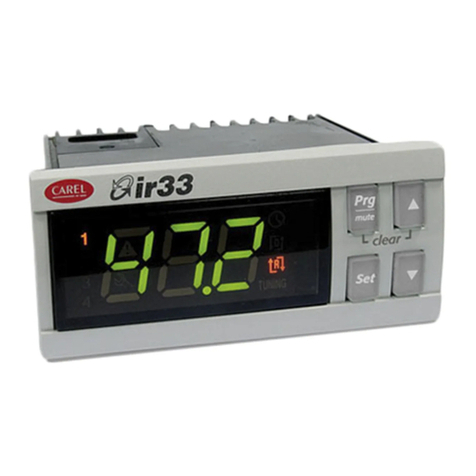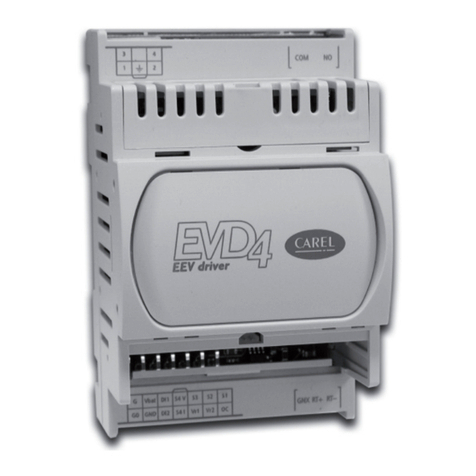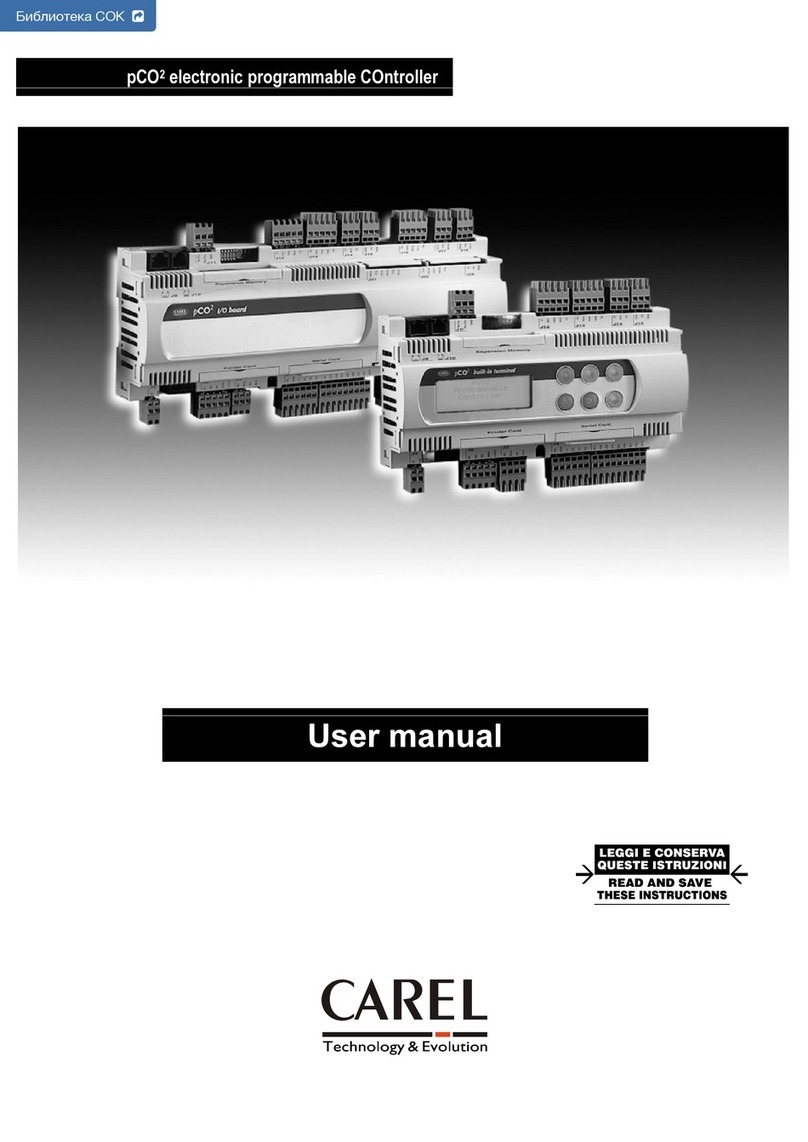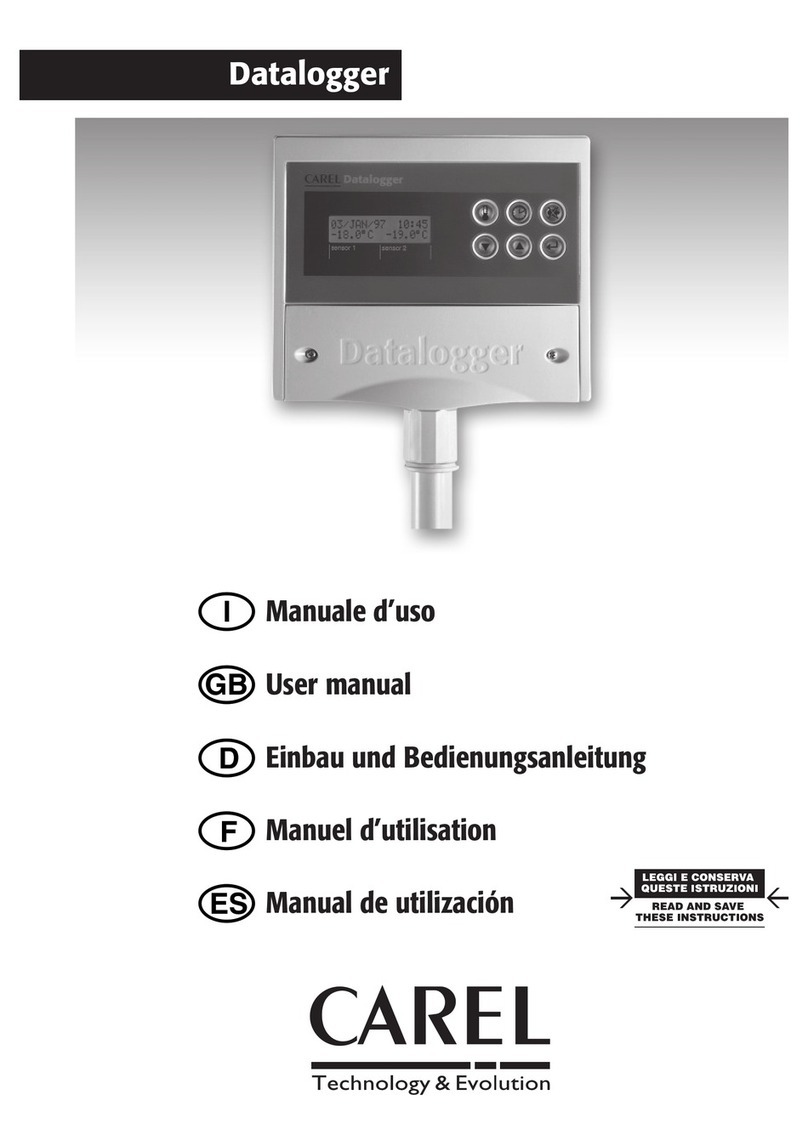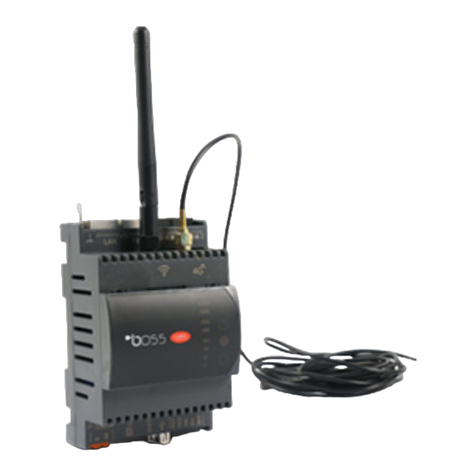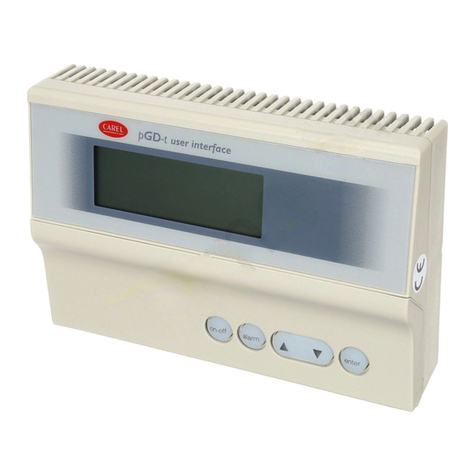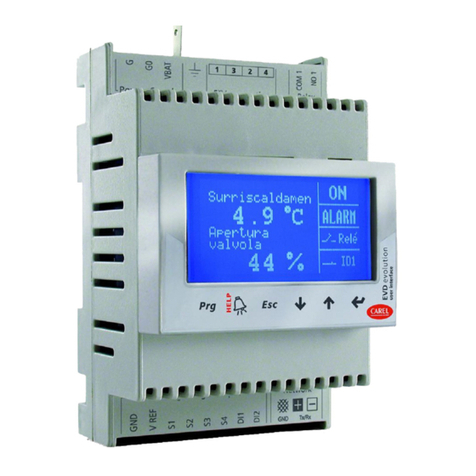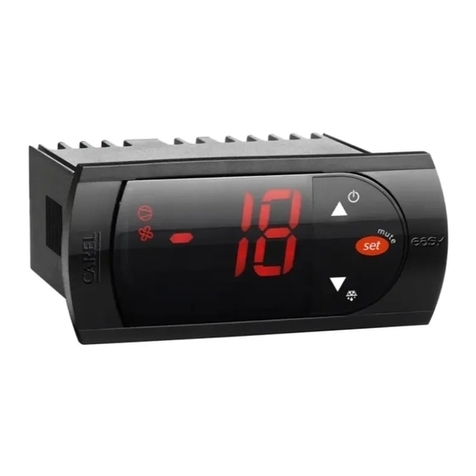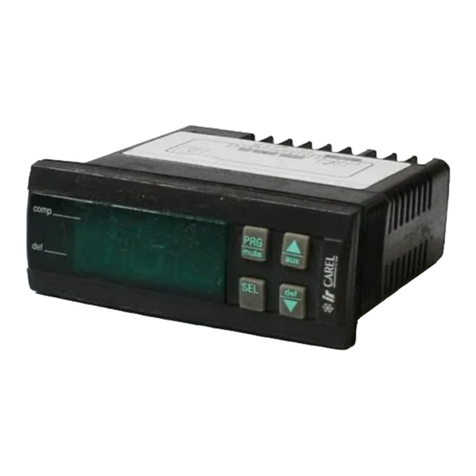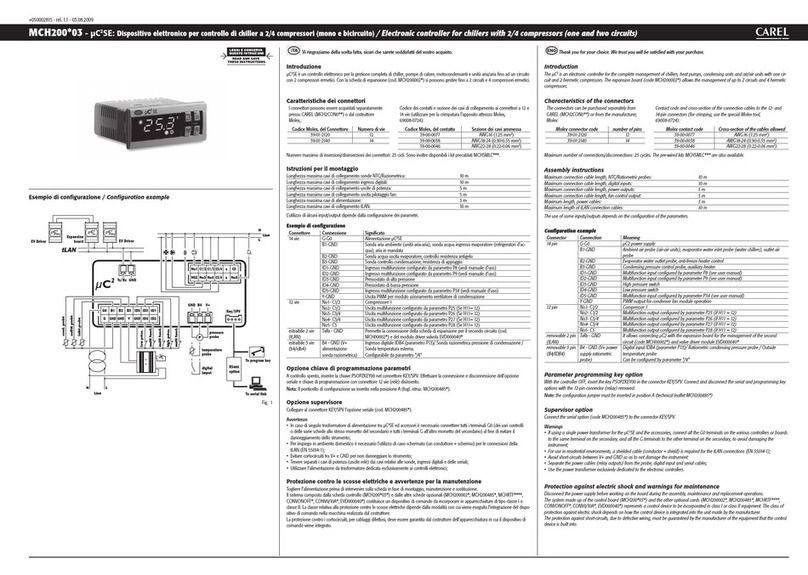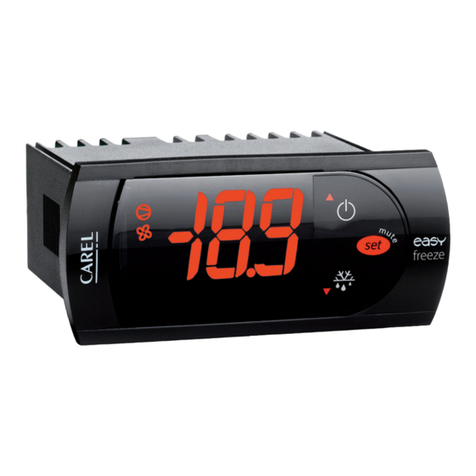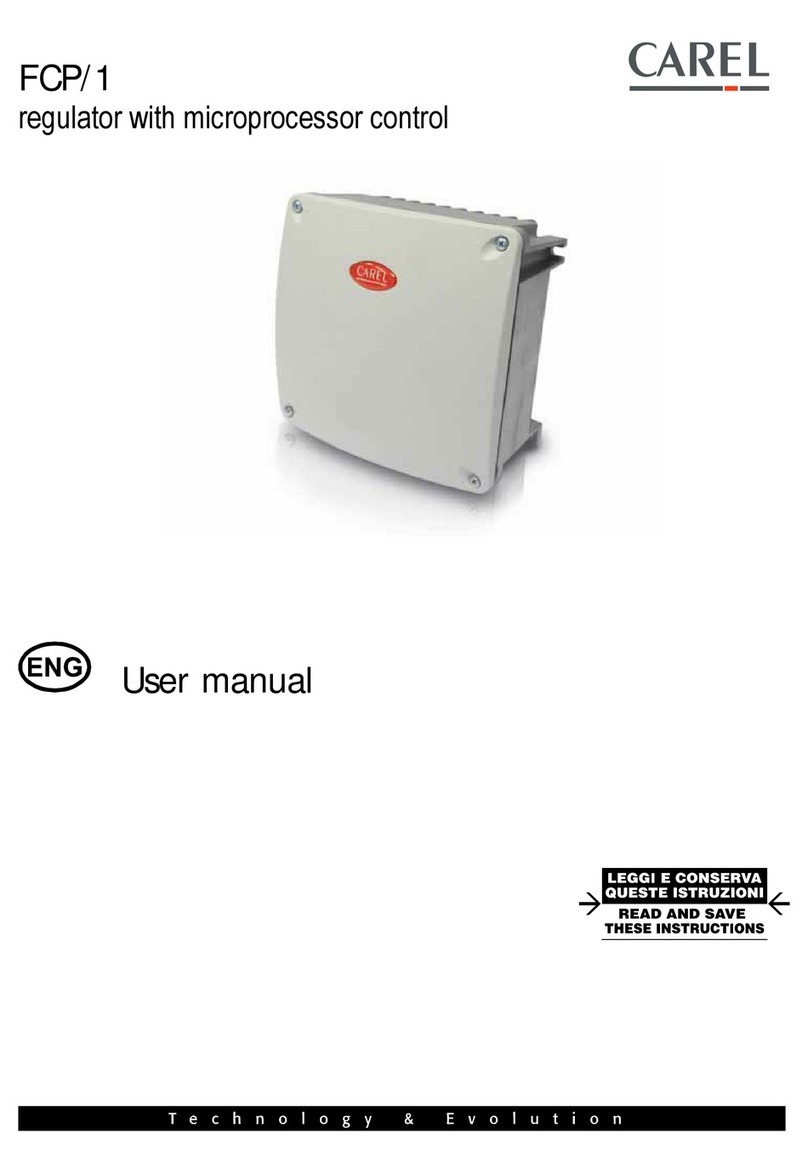
CAREL S.p.A.
Via dell’Industria, 11 - 35020 Brugine - Padova (Italy)
Tel. (+39) 0499716611 – Fax (+39) 0499716600
http://www
.carel.com
–
e-mail:
[email protected] +050000740 - rel. 1.3 del 18.04.2013Funzioni alternative dei tasti:
Tasto Premere per… Funzione svolta
3 secondi OFF dell’impianto con disabilitazione fasce orarie ( visualizzazione OFF ner campo 2in fig. 4)
3 secondi Consente l’impostazione del setpoint unico per tutti e-drofan
3 secondi Consente l’impostazione delle fasce orarie (ora, giorno, setpoint,On/Off)
5 secondi Consente l’impostazione dell’orologio (apparirà la scritta rtc)
Nota:la disponibilità delle funzioni indicate dipende dal modello in vostro possesso e da come viene configurato e integrato nell’impianto.
Per una descrizione dettagliata consultare il manuale del µAM.
Modifica parametri
Per visualizzare i parametri, premere il tasto , quindi rilasciarlo e mantenere premuto per 3 secondi il tasto . Selezione e modifica
avvengono rispettivamente con i tasti , , . Per uscire salvando le impostazioni mantenere premuto per 3 secondi oppure
per non salvare le modifiche attendere 1 minuto senza premere alcun tasto.
La tabella seguente illustra il significato dei parametri di funzionamento:
Nome Descrizione min. max. def u.m.
Ch01 Tipo change-over (0= nessuno, 1= energy saving (En02= 1), 2= delta temp. locale µAM,
3= richieste e-drofan, 4= delta temp e-drofan)
04 0-
Ch02 Differenziale change-over 1 20 3 °C
Ch03 Intervallo di tempo tra 2 change-over 15 60 20 min
Co01 Compensazione set chiller (0= nessuna, 1= delta temp e-drofan, 2= delta temp. locale µAM) 0 2 0 -
Co02 Differenziale temp. massimo per compensazione in cooling 1 20 2 °C
Co03 Differenziale temp. massimo per compensazione in heating 1 20 2 °C
Hu01(1) Setpoint umidità 10 80 50 %RH
Hu02(1) Differenziale umidità in umidifica (se Hu02= 40 la funzione di umidifica viene disattivata) 5 40 10 %RH
Hu03(1) Differenziale umidità in deumidifica (se Hu03=40 la funzione di deumidifica viene disattivata) 5 40 10 %RH
En01 Presenza µChiller2SE (0= assente, 1= presente) 0 1 1 -
En02 Impianto a 4 tubi (0= 2 tubi, 1= 4 tubi solo se µChiller2SE non è HP) 0 1 0 -
En03 Boiler comandato da µChiller2SE (0= assente, 1= presente) 0 1 0 -
En04 Abilita orologio e funzioni relative (0= disabilitatato, 1= abilitato) 0 1 1 -
En05 Blocco tastiera e-drofan (0= sbloccata, 1-9 Blocco selettivo(2))090-
Pc01 Calibrazione sonda -9.9 9.9 0.0 °C
Fr01 Visualizza versione firmware - - - -
(1) Solo se il modello monta la sonda di umidità (versioni ADEF*, ADEG*, ADEH*).
(2) Vedi manuale e-drofan.
Allarmi
Se durante il funzionamento si verifica una situazione di allarme, il terminale mostrerà il simbolo lampeggiante e, alternativamente alla
visualizzazione normale, i codici degli allarmi. Di seguito il loro significato:
Allarme Significato
Ach Allarme attivo del µChiller2SE
A0n Allarme attivo e-drofan: n= codice allarme, il campo 1in Fig. 4 indica l’e-drofan in allarme
Och Offline: mancanza di comunicazione tra µAM e µChiller2SE
OFC Offline: mancanza di comunicazione tra µAM e e-drofan, il campo 1in fig. 4 indica l’e-drofan offline, mentre se 1è spento e En01=
0 significa che nessun e-drofan è in linea
UEr il µAM è connesso ad una periferica di tipo diverso da µChiller2SE o e-drofan, il campo 1in fig. 4 indica l’indirizzo della
periferica errata, se il campo 1e il simbolo e-drofan sono spenti l’errore si riferisce al µChiller2SE
AtEAllarme sonda di Temperatura interna
Ahu Allarme sonda di Umidità interna
vv
Caratteristiche Tecniche
• Tensione di alimentazione:
24 Vac ±15 %, 50/60 Hz 70 mA 1,5 VA oppure 31 Vdc ± 29 % 70 mA (secondo EN60730-1)
• Classificazione secondo UL873:
Ingresso alimentazione : 24 V ac, 50-60Hz, Class 2
25.5 - 36.25 V dc, Class 2
Power consumption, max 1 watt
Uscite: serial link RS485, Class 2
• Condizioni di funzionamento: 0T50 °C; 10...85% U.R. non condensante.
• Condizioni di immagazzinamento: -20T70 °C; 0...85 % U.R. non condensante.
• Dimensioni (mm): vedi Fig. 3;
• Inquinamento ambientale: normale;
• Grado di Inquinamento: grado II;
• Categoria di resistenza al calore e al fuoco: A;
• Classe e struttura del software: A;
• Grado di protezione contro gli agenti atmosferici: IP30;
• Temperatura della ball pressure test sulle plastiche dell’involucro: 100 °C;
• Classificazione secondo protezione contro scosse elettriche (EN60730-1): III, da integrare in apparecchi di classe I o II;
• Periodo sollecitazioni elettriche delle parti isolanti: lungo;
• Dispositivo di comando previsto per essere fornito a: costruttori, installatori e manutentori;
• Protezione contro i cortocircuiti: deve essere garantita dal costruttore dell’apparecchiatura in cui il µAM viene integrato o
dall’installatore finale;
• Immunità contro sovratensioni: categoria 1;
• Sezione dei conduttori (mm2): da 0,5 a 1,5 mm2;
• Precisione della misura di temperatura : +/-2 °C;
• Precisione della misura di umidità*: +/-10% rH.
*nei modelli dotati di sonda di umidità opzionale.
Mode
135 mm 30
86 mm
POWER
MODE
FANCOIL
SLEEP
CLOCK
TEMP
83.5 mm
43.25 mm
Interfaccia utente/User interface
1 2 3 4 5 6 7
HR
°C
set
% rH
°C
riscald. / raffred. / auto / deumid. / umid.
heating / cooling / auto / dehumid. / humid. temp. / umid. / set (*)
temp. / humid. / set (*)
(*): dipende dalle impostazioni dei parametri / depending on the parameter setting
fascia oraria / durata sleep / num. fancoil
time band / sleep duration / fancoil ID
modifica o allarme fancoil
fancoil modification or allarm
ora / temp. fancoil
hour / fancoil temp.
on/off fascia oraria
on/off time band
giorno settimana
week day
unità di misura
unit of measurement
allarme attivo
active alarm
1
2
3
Indicazioni display/Indications on the display
Fig. 4
Alternative functions of the buttons:
Button Press for… Function carried out
3 seconds OFF of the system with time slots disabled (view OFF black field 2in fig. 4)
3 seconds Allows one to set the setpoint that is unique for all the e-drofan
3 seconds Allows one to set the time slots (time, day, setpoint, On/Off)
5 seconds Allows one to set the clock (the letters rtc will appear)
Note: the availability of the functions indicated depends on the model you possess and how it is set and integrated into the system. See
the µAM manual for a detailed description.
Change the parameters
To view the parameters, press the key , then release it and keep the key then release it and keep the. Select and change take place
respectively with the , , keys. To exit, saving the settings, keep the key pressed for 3 seconds or if one does not want to
save the changes made, wait 1 minute without pressing any keys.
The following table shows the meaning of the operational parameters:
Name Description min. max. def u.m.
Ch01 Change-over type (0= none, 1= energy saving (En02= 1), 2= local µAM delta temp
3= e-drofan requests, 4= e-drofan delta temp)
04 0 -
Ch02 Change-over differential 1 20 3 °C
Ch03 Time interval between 2 change-overs 15 60 20 min
Co01 Set chiller compensation (0 = none, 1 = e-drofan delta temp., 2 = local µAM delta temp. 0 2 0 -
Co02 Maximum temp differential for compensation in cooling 1 20 2 °C
Co03 Maximum temp differential for compensation in heating 1 20 2 °C
Hu01(1) Humidity setpoint 10 80 50 %RH
Hu02(1) Humidity differential in humidifying (if Hu02= 40, the humidifying function is disabled) 5 40 10 %RH
Hu03(1) Humidity differential in humidifying (if Hu03= 40, the humidifying function is disabled) 5 40 10 %RH
En01 µChiller2SE Present (0= absent, 1= present) 0 1 1 -
En02 4 pipe system (0= 2 pipes, 1= 4 pipes only if µChiller2SE is not HP) 0 1 0 -
En03 Boiler controlled by µChiller2SE (0= absent, 1= present) 0 1 0 -
En04 Clock ability and relative functions (0= disabled, 1=active) 0 1 1 -
En05 E-drofan key lock (0=unlocked, 1-9 selective lock 2(2))090-
Pc01 Probe calibration -9.9 9.9 0.0 °C
Fr01 View firmware version - - - -
(1) Only if the model has a humidity probe fitted (ADEF*, ADEG*, ADEH* versions).
(2) See e-drofan manual.
Alarms
If there is an emergency situation will operating, the terminal will show a flashing symbol and, unlike in normal viewing, the alarm codes.
Their meanings are explained below:
Alarm Meaning
Ach Alarm set off by the µChiller2SE
A0n Alarm set off by e-drofan. n= alarm code, the field 1in Fig. 4 shows the e-drofan in an emergency
Och Offline: lack of communication between µAM and µChiller2SE
OFC Offline: lack of communication between µAM and e-drofan, the 1field in fig. 4 shows the offline e-drofan, while if 1is off and
En01= 0, this means that there is no e-drofan on line.
UEr The µAM is connected to a peripheral unit that differs from the µChiller2SE or e-drofan, the 1field in fig. 4 shows the address of the
incorrect peripheral unit. If the 1field and the e-drofan symbol are off, the error refers to the µChiller2SE
AtEInternal Temperature probe alarm
Ahu Internal Humidity probe alarm
Technical specifications
• Power voltage: 24 Vac ±15 %, 50/60 Hz 70 mA 1.5 VA or 31 Vdc ± 29 % 70 mA (according to EN60730-1)
• Classification according to UL873:
Power supply input: 24 V ac, 50-60 Hz, Class 2
25.5 - 36.25 V dc, Class 2
Power consumption, max 1 watt
Outputs: serial link RS485, Class 2
• Operating conditions: 0T50 °C; 10 to 85% rH non condensing
• Storage conditions: -20T70 °C; 0 to 85% rH non condensing
• Sizes (mm): see Fig. 3;
• Environmental pollution: normal;
• Level of pollution: level II;
• Category of heat and fire resistance: A;
• Software class and structure: A;
• Level of protection against atmospheric agents: IP30;
• Temperature of the ball pressure test on the wrapping plastics: 100 °C;
• Classification according to protection against electrical shocks (EN60730-1): III, to be integrated into cat. I or II apparatus;
• Period of electric stress across the insulating parts long;
• Control device to be distributed to: builders, installers and maintenance workers;
• Protection against short circuits: the manufacturer or end installer must guarantee apparatus with integrated µAM;
• Immunity against voltage surges: category 1;
• Conductor section (mm2): from 0.5 to 1.5 mm2;
• Temperature measurement precision: +/-2 °C;
• Humidity level* measurement precision: +/-10% rH.
*in the models fitted with optional humidity probe.
Fig. 3
Smaltimento/ Disposal
L’apparecchiatura (o il prodotto) deve essere oggetto di raccolta separata in conformità alle vigenti normative locali in materia di smaltimento.
The appliance (or the product) must be disposed of separately in compliance with the local standards in force on waste disposal.
AVVERTENZE IMPORTANTI
Il prodotto CAREL è un prodotto avanzato, il cui funzionamento è specificato nella documentazione tecnica fornita col prodotto o scaricabile, anche anteriormen-
te all’acquisto, dal sito internet www.carel.com. Il cliente (costruttore, progettista o installatore dell’equipaggiamento finale) si assume ogni responsabilità e rischio in
relazione alla fase di configurazione del prodotto per il raggiungimento dei risultati previsti in relazione all’installazione e/o equipaggiamento finale specifico.
La mancanza di tale fase di studio, la quale è richiesta/indicata nel manuale d’uso, può generare malfunzionamenti nei prodotti finali di cui CAREL non potrà
essere ritenuta responsabile. Il cliente finale deve usare il prodotto solo nelle modalità descritte nella documentazione relativa al prodotto stesso.
La responsabilità di CAREL in relazione al proprio prodotto è regolata dalle condizioni generali di contratto CAREL editate nel sito
www.carel.com e/o da specifici accordi con i clienti.
IMPORTANT WARNINGS
The CAREL product is a state-of-the-art device, whose operation is specified in the technical documentation supplied with the product or can be downloaded, even
prior to purchase, from the website www.carel.com. The customer (manufacturer, developer or installer of the final equipment) accepts all liability and risk relating
to the configuration of the product in order to reach the expected results in relation to the specific installation and/or equipment. The failure to complete such
phase, which is required/indicated in the user manual, may cause the final product to malfunction; CAREL accepts no liability in such cases.
The customer must use the product only in the manner described in the documentation relating to the product. The liability of CAREL in relation to its products is
specified in the CAREL general contract conditions, available on the website www.carel.com and/or by specific agreements with customers.


